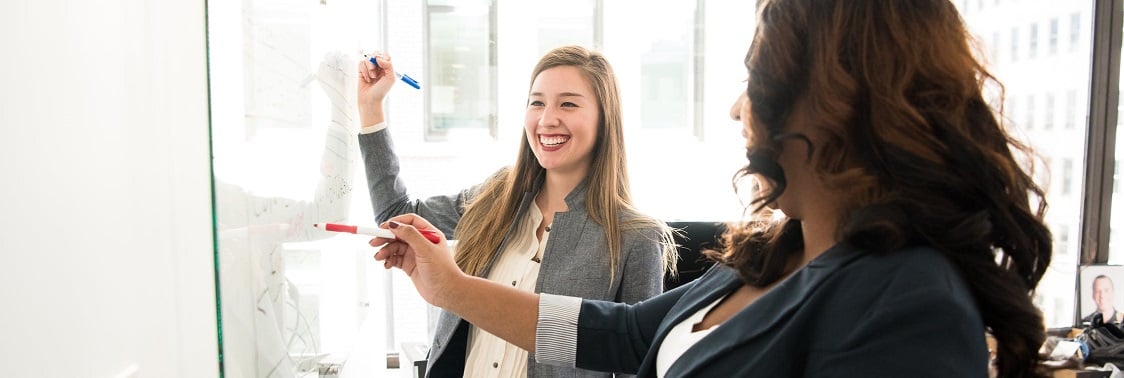Reset Company Culture: 4 Steps to Take as You Define Your Organization’s ‘New Normal’

With so many changes happening in a short time stemming from the COVID-19 pandemic and social crises, employers face important decisions on how to go forward in managing their teams and adapting for today’s realities. It’s a good time to look at where your business is now and apply what you’ve learned over the past several months. It’s also important to look at ways you are listening to and connecting with employees, and opportunities for greater focus on diversity and inclusion.
What to do next? Consider a cultural reset.
We commonly think of culture as the “way things are done” in an organization. Culture embodies the vision, values, norms and habits that drive employee behaviors as they complete their day-to-day work. Many employee work habits and experiences have changed in the first half of 2020, and some companies have made dramatic shifts to adapt. There is a good chance culture shifts aren’t far behind.
As you move forward to define new ways of working – and the culture to support them – tune in to what employees want and be willing to have courageous conversations.
As you reset company culture and define your organization’s ‘New Normal’ think about these cultural elements:
- Organizational strategy and purpose – Confirm your mission and vision in light of the “new normal.” Has anything changed? Do the values and behaviors from the past continue to serve the mission and vision, or do they need to be adjusted?
- Values and behaviors – Do some values and behaviors need to be jettisoned, or added in the context of the new business environment? Where can you better emphasize the importance of diversity, inclusion and mutual respect? What combination of values and behaviors will best serve the mission and vision in this new environment? How will they be defined and measured?

- Core processes and systems – How have your operations and processes changed with stay-at-home orders and remote work? What structures or systems could be improved to embrace employees’ differences and unique backgrounds? How can your human resources, operational and financial procedures be adjusted to better meet employees’ current needs – whether for more flexible and remote work options or for fairness, equality and parity across races, genders and age groups?
- Motivation and recognition – What have you learned from employees about their needs and motivations in light of the stay-at-home orders and civil rights movements? How can these needs be addressed by supervisors and managers to build trust in the new work environment? In what ways can you encourage collaboration and build community as part of your culture? How can you structure rewards and recognition – whether from leaders or peers – to reinforce desired behaviors and new ways of working?
- Employee engagement and input – In what ways can employees provide input to the day-to-day operation of your company and what processes are in place to respond to their feedback? A recent survey by The Grossman Group found that 48% of employees working at home for their employer during COVID-19 want to work remotely after COVID-19. While remote work isn’t for everyone, employees crave flexibility in their work environment. Be sure you have thoughtful approaches in place to help employees feel heard and supported as needs and situations change. This can lead to more engagement and greater commitment to the company’s goals.
- Manager and leader readiness – What role will managers and leaders play in the culture shift, and what do you need them to know, feel and do to be successful? Be sure that these leaders understand their important role in modeling new behaviors, communicating expectations and guiding employees to a new way of working. Pay special attention to preparing front-line leaders for their communication role in leading the change.
- Cultural resiliency – When you are creating your workplace of the future, consider how you can build cultural resiliency so your team can readily adapt when more changes inevitably come. According to a recent Gallup report, resiliency in tough times includes focusing on the basics: clarifying roles, ensuring employees have what they need to do their work, putting them in a position to do their best work, helping people see how their work connects to a bigger purpose and having extremely high standards for quality across all teams.

Create and Communicate Your Culture Change Strategy
Like any change effort, a purposeful culture shift will be more palatable to employees if they are involved in developing the approach. Engaging employees as you consider the factors for the cultural reset above, and incorporating their input on work styles and location options, will help advance a positive outcome. It’s good to follow key steps in a change management process to ensure you have a well-thought-out plan for rolling out the new culture.

Evaluate Change Impact and Organizational Readiness
- Assess the culture, climate and what’s changing by understanding the current state and defining the challenges, barriers and opportunities ahead.
- Create a case for change statement (what’s changing and why) and document required changes in specific norms and behaviors.
- Clearly define success and how it will be measured to create a baseline for planning.
- Consider and plan support for the stakeholders who will experience the greatest impact from the change in culture.

Formulate the Change Management Strategy
- Prioritize key aspects of the culture change by articulating the desired end state, including language, competencies and observable employee behaviors.
- Align sponsorship and leadership with a clear understanding of who will be the visible change sponsor and what other leaders need to do for the effort to be successful.
- Ensure appropriate management systems are in place to support changes so that success is reinforced, and people are rewarded for new behaviors rather than the old way of working.
- Define feedback channels, responsibilities for follow-up and ways to evaluate and respond to input.
- Develop communications and engagement strategies that help leaders to share the vision and employees to understand the part they play in its success.

Develop and Execute the Change Management Plan
- Develop the stakeholder analysis, identifying specific groups, impacts, needs and potential resistance to the change.
- Define and engage resources needed (i.e., HR, technology, budget, etc.).
- Engage sponsors, leaders and change agents, including defining their responsibilities, confirming expectations and providing training.
- Equip managers and supervisors with knowledge and training needed to model new behaviors, support the culture change and communicate effectively.

Communicate the Change, Highlight Successes and Reinforce Results
- Deliver communications to target audiences according to the plan, check for understanding and modify as needed.
- Engage leaders, managers, supervisors and change agents to communicate and reinforce key behaviors.
- Ensure leaders and change agents are actively collecting and responding to feedback and bringing it forward to inform the project communications effort.
- Share information and adapt based on feedback.
Tips for success as you reset company culture:
- Balance quick wins with long-term success – Identify key milestones in the roadmap to your culture vision and communicate often to ensure employees know where you are on the journey. Celebrate as milestones are reached and keep people motivated by highlighting small victories and behaviors you want to see.
- Talk about what’s changing and why – Help employees understand what’s changing, why it’s changing, what it means for them and how they can contribute. It’s especially important to have a consistent framework and definitions of your culture and behaviors to guide the transition and minimize misinterpretation.
- Listen carefully and respond – Create and use informal and formal feedback channels to gather employee views and perceptions. Use their feedback and ideas to make decisions and loop back to let employees know they were heard and that their input was put to good use. When employees feel genuinely represented, they’ll be more likely to support change.
- Remember one size does not fit all – Understand and tailor messages to meet the diverse needs of your key audiences, especially employees. Provide specific information and behavioral guidance suited for the unique needs of various roles – from front-line employees with production or service/support responsibility, to leadership roles, to those who communicate with customers or third-party partners. When employees feel connected, their engagement will be stronger and results will be better.
- Don’t assume everyone’s in the know – With so much change happening so quickly these days, don’t assume employees are aware of everything going on. Communicate regularly and keep repeating key messages and expectations. Some employees may just be hearing and making sense of it for the first time.

As you continue to lead through these unprecedented times, consider the positive impact you can make by thoughtfully evolving your company culture in response to the needs and concerns of your employees. When you focus on being purposeful with culture, you can seize the opportunity of the moment and be well-positioned to adapt to future changes ahead.
Thinking about the culture in your workplace, how might a reset help your organization continue to be even more effective as you move forward?
—David Grossman
Ready to transform your company culture? Click below to download your free copy of our eBook, Guide to Organizational Culture Change, today!



Comments on this post